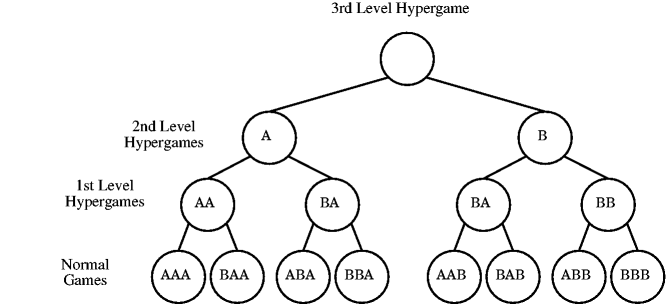Homepage for Lachlan Brumley
What is a hypergame?A hypergame is a game-theoretic modelling methodology that allows us to model games that utilise imperfect information, which traditional games cannot. A hypergame uses multiple games to model each players perception of the situation, of which these sub games may also be hypergames. Consider the hypergame below, that shows a two player hypergame between A and B.
 The overall hypergame is made of two hypergames, one of which represents the game that A believes is being played, the other the game that B believes is being played. A's hypergame (A) consists of two smaller hypergames - AA and BA. AA is another hypergame that models the game that A believes it is playing, while BA is the hypergame that A believes B is playing against A. At the lowest levels of the games, AAA is the game that player A believes it is playing, while BAA is the game that it believes B is playing against A. Also ABA is perceived by player A to be the game that A believes B thinks it is playing against A, while BBA is the game that A believes B thinks it is playing. Simple isn't it :). While the varying levels of perception can become confusing, they allow us to model situations such as "A thinks that B thinks that A will do X", which allows for modelling of deception, bluffs and counter-bluffs. HYPANTHYPANT is a HYPergame ANalysis Tool that I created as part of my 2003 Honours project (Standalone Page Here). It implements the analysis methods of Fraser and Hipel. Currently it is capable of analysing existing games stored in a Hypergame Modelling Language (HML).Future extensions would allow users to create hypergames for analysis using a graphical interface or see the hypergame analysis core reused in other applications. HYPANT is available under the GNU General Public License. For further information about HYPANT or HML see my Honours ThesisFor a possible look at some images that HYPANT could be modified to produce look at these 3D diagrams of hypergame structures |